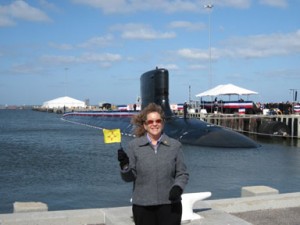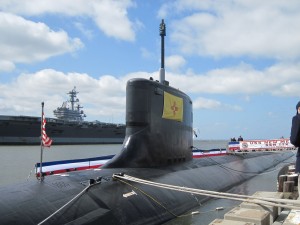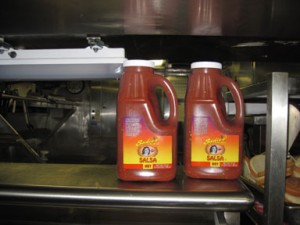Across the country, museums are looking for ways to expand visitors’ social experiences as well as become community gathering spots. (Consultant Nina Simon documents the cutting edge in her blog, Museum 2.0.) The History Museum does its part with hands-on exhibits, lectures and performances, and a shady Palace courtyard in the heart of downtown Santa Fe, perfect for a moment of serenity.
On May 20, we’re taking that one step further by offering a place to grab a snack or a light meal, hang out on a second-story terrace with a great view, get a little work done courtesy of our free wi-fi, and re-charge before charging back into the exhibits.
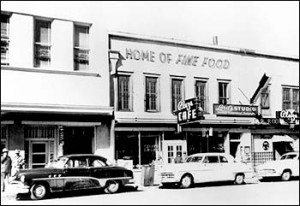 The Plaza Cafe, a Santa Fe Plaza mainstay since 1905, has agreed to run the long-awaited Cowden Café, on the museum’s second floor. The café will serve daily from 10 am until 4:30 pm, and on Friday from 11 am until 7 pm. Service will be “upscale self-service without the attitude,” said Daniel Razatos, whose family has operated the Plaza Café for more than six decades. All menu items will be made from scratch and designed to be quick, healthy and fresh – perfect for people on a one-hour lunch break. Beverages will include premium coffees, teas, beer and wine, creating an opportunity to enjoy not only the exhibits but sunset hors d’oeuvres and, sometimes, live music on the café’s Phyllis and Eddie Gladden Terrace.
The Plaza Cafe, a Santa Fe Plaza mainstay since 1905, has agreed to run the long-awaited Cowden Café, on the museum’s second floor. The café will serve daily from 10 am until 4:30 pm, and on Friday from 11 am until 7 pm. Service will be “upscale self-service without the attitude,” said Daniel Razatos, whose family has operated the Plaza Café for more than six decades. All menu items will be made from scratch and designed to be quick, healthy and fresh – perfect for people on a one-hour lunch break. Beverages will include premium coffees, teas, beer and wine, creating an opportunity to enjoy not only the exhibits but sunset hors d’oeuvres and, sometimes, live music on the café’s Phyllis and Eddie Gladden Terrace.
“Museums are changing,” said Dr. Frances Levine, director of the museum. “It’s not just about visiting the exhibits, it’s about being comfortable in public spaces and providing amenities to help people feel comfortable. We want our museum to be a place for the community.”
Brothers Andy and Daniel Razatos operate the Plaza Café, founded in 1905 and taken over by Dionysi Razatos in 1947. A longtime favorite among locals, tourists and the occasional celebrity, the restaurant whips up a mix of Greek, New Mexican and down-home American cuisines – everything from moussaka to enchiladas to chicken-fried steak.
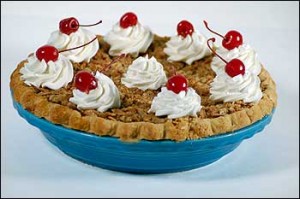 “The Cowden Café will be like a little café bistro,” said Daniel Razatos. “You come in for a little snack, nothing’s very huge or expensive, and it’s a nice, comfortable atmosphere to hang out and read your newspaper – very European.”
“The Cowden Café will be like a little café bistro,” said Daniel Razatos. “You come in for a little snack, nothing’s very huge or expensive, and it’s a nice, comfortable atmosphere to hang out and read your newspaper – very European.”
Visitors who only want to go to the café can do so for free; access to the exhibits will remain limited to paid attendees. Up to 20 people can sit inside the café; the outdoor terrace has room for 50 people. The museum is working out the final tweaks to a wi-fi system that will enable members of the public to log on to their computers while visiting the café.
The Cowden Café is named for a historic ranching family, whose holdings at one time straddled the New Mexico-Texas border from Jal to Santa Rosa. Their legacy was detailed in the book Riding for the Brand: 150 Years of Cowden Ranching (University of Oklahoma Press, 2006), by Michael Pettit.
Part of the 1-year-old History Museum’s original design, the café and terrace have been closed to the public while details on the café’s operation were worked out. The state Board of Finance agreed to the contract’s terms on April 20, clearing the way for a final construction push.

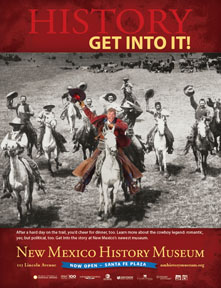
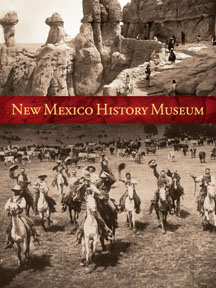 That campaign just won honors from the
That campaign just won honors from the 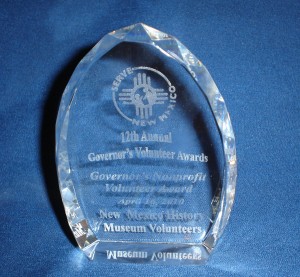 Last week, the New Mexico History Museum’s many volunteers were honored with a prestigious award by the
Last week, the New Mexico History Museum’s many volunteers were honored with a prestigious award by the 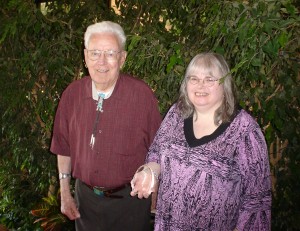 John Ramsay accepted a last-minute invitation from Patricia to attend the event and said it was just another never-know-what-to-expect day in the life of a volunteer. For the last 14 years, Ramsay has volunteered at the History Library, most of that time “in the bowels” of archived documents. While helping with cataloguing and such, he’s honed an interest in Southwest history deep enough to lead him to contribute a chapter to a book that will be published by
John Ramsay accepted a last-minute invitation from Patricia to attend the event and said it was just another never-know-what-to-expect day in the life of a volunteer. For the last 14 years, Ramsay has volunteered at the History Library, most of that time “in the bowels” of archived documents. While helping with cataloguing and such, he’s honed an interest in Southwest history deep enough to lead him to contribute a chapter to a book that will be published by 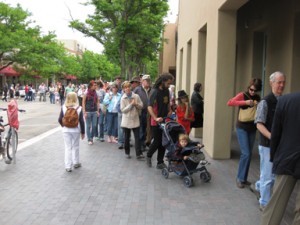
 Also in the magazine is an article noting 25 kid-friendly museums, and it names the Native American Artisans Portal Program (left) at the Palace of the Governors.
Also in the magazine is an article noting 25 kid-friendly museums, and it names the Native American Artisans Portal Program (left) at the Palace of the Governors.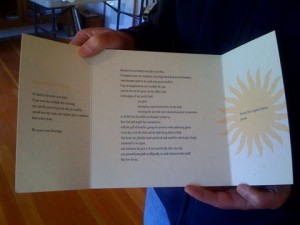
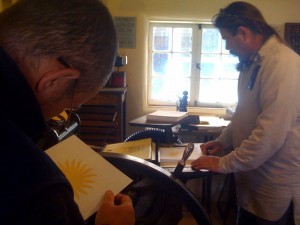
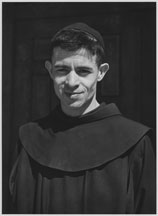 The beauty of that culture was threaded throughout Chávez’s life. Born Manuel Ezequiel Chávez in Wagon Mound, N.M., Fray Angélico was ordained as a Franciscan, served several parishes in New Mexico and was instrumental in renovating the church in Peña Blanca – a true hands-on effort. The murals he painted of the Stations of the Cross used images of himself, his family and parishioners. He also renovated churches in Domingo Station, Golden and Cerrillos.
The beauty of that culture was threaded throughout Chávez’s life. Born Manuel Ezequiel Chávez in Wagon Mound, N.M., Fray Angélico was ordained as a Franciscan, served several parishes in New Mexico and was instrumental in renovating the church in Peña Blanca – a true hands-on effort. The murals he painted of the Stations of the Cross used images of himself, his family and parishioners. He also renovated churches in Domingo Station, Golden and Cerrillos.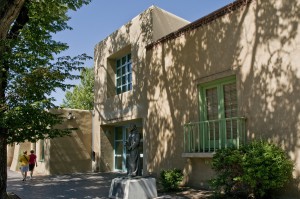 After his death in 1996, the History Library was named in his honor, and a bronze statue of him graces its entrance. A self-portrait is on display in the Palace of the Governors’ Portrait Gallery, and it carries an interesting tale. Painted in 1939 as an “idle sketch” on a board by Fray Angélico in 1939, it was later trimmed down to repair a drawer in the convent at Peña Blanca. In 1970, someone cleaning out the drawers happened upon it. Fray Angélico donated it to the museum, writing: “I thought you might display it more as a curiosity than a work of art.”
After his death in 1996, the History Library was named in his honor, and a bronze statue of him graces its entrance. A self-portrait is on display in the Palace of the Governors’ Portrait Gallery, and it carries an interesting tale. Painted in 1939 as an “idle sketch” on a board by Fray Angélico in 1939, it was later trimmed down to repair a drawer in the convent at Peña Blanca. In 1970, someone cleaning out the drawers happened upon it. Fray Angélico donated it to the museum, writing: “I thought you might display it more as a curiosity than a work of art.”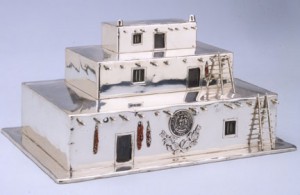 The New Mexico History Museum holds the set and has several of its pieces on display in its core exhibition, Telling New Mexico: Stories from Then and Now. Each piece was handcrafted to reflect different aspects of the state’s cultural heritage – Coronado’s Expedition 1540-42; San Miguel Chapel – Oldest Church in the US; and the First Locomotive through Raton Pass – 1879. Pretty much everyone’s favorite piece is a humidor in the shape of Taos Pueblo. (That’s it at left and, if you know which viga to press on, you can pop open the various floors of the “pueblo.”)
The New Mexico History Museum holds the set and has several of its pieces on display in its core exhibition, Telling New Mexico: Stories from Then and Now. Each piece was handcrafted to reflect different aspects of the state’s cultural heritage – Coronado’s Expedition 1540-42; San Miguel Chapel – Oldest Church in the US; and the First Locomotive through Raton Pass – 1879. Pretty much everyone’s favorite piece is a humidor in the shape of Taos Pueblo. (That’s it at left and, if you know which viga to press on, you can pop open the various floors of the “pueblo.”)